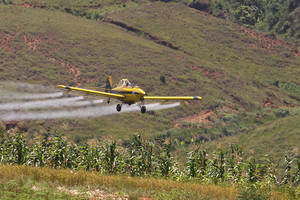Locust Plague in Madagascar Halted, For Now
 A locust plague that spread across Madagascar threatening the main staple food crops and pasture in the country has been successfully contained, however, progress is under threat due to a gap in funding, Food and Agriculture Organization of the United Nations (FAO) said.
A locust plague that spread across Madagascar threatening the main staple food crops and pasture in the country has been successfully contained, however, progress is under threat due to a gap in funding, Food and Agriculture Organization of the United Nations (FAO) said.
At the beginning of the plague in April 2012 the highly destructive Malagasy Migratory Locust ravaged crops and pastures on its way from the southwest of the country toward the North. By April 2014, it had spread towards the country’s largest rice crop areas in the northwest and threatened the livelihoods of 13 million people.
Potential for further damage was contained by the first locust control campaign, which is part of a three-year program jointly executed by FAO and the Government of Madagascar, in close collaboration with the Ministry of Agriculture and Rural Development.
A total of $28 million has been donated so far by the governments of Austria, Belgium, France, Italy, Japan, Madagascar through a World Bank loan, Norway and the United States, as well the European Union and the United Nations Central Emergency Response Fund. Donors also include Algeria, Mauritania and Morocco, which donated pesticides.
Funds available so far are only sufficient to implement the first part of the second locust control campaign, which started in September 2014. With the onset of the rainy season, from October 2014 onwards, the locust situation will deteriorate as seasonal temperatures and humidity at this time are ideal breeding conditions for the locust. The second and third campaigns are imperative to respectively support the decline of the plague and the return to a situation of recession.
Additional support of $14.7 million is urgently needed for aerial surveys, control operations, equipment, pesticides, as well as the recruitment of key staff to carry out the second and third campaigns.
More information can be found at the FAO.






